Thousands of young people gave up their studies to march to the frontlines with the belief that victory was at hand.
In 1970, when the fight against the Americans in the south stepped into a fiercer period, the liberation forces in southern frontlines needed more troops. The north published a mass national conscription order, encouraging young people including students to join the liberation army.
More than 10,000 students in the north stopped their studies to go to battle in the south between 1970 and 1972.
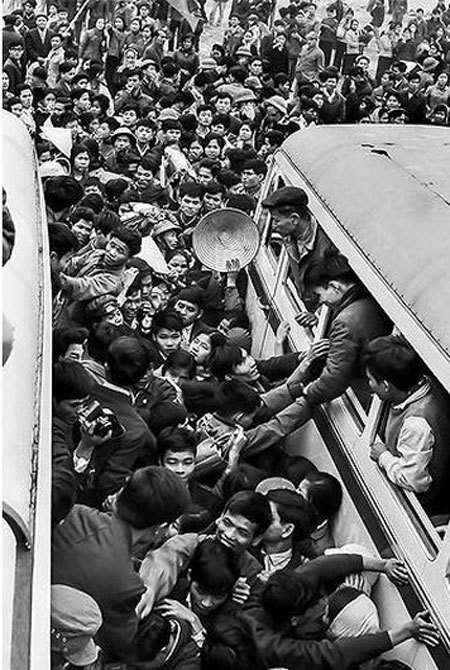 |
| Students from Hanoi National University say goodbye to their families, friends and teachers to depart for the southern battle in 1971. VNA/VNS File Photo |
Many of them were in their first year while others had nearly graduated; some even were preparing for further study overseas.
The busiest army recruitment period was in 1971 when thousands of students joined right at the start of the new academic year.
The army joining ceremony held on September 6, 1971, took place in the yards of many universities. Young students were seen off by their friends and teachers. Most of them looked quite young with joy in their faces wearing white shirts.
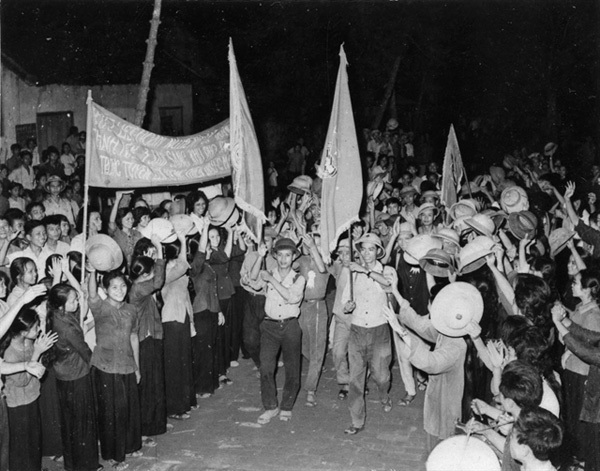 |
| People join a farewell ceremony for young people in Dong Da District, Hanoi on August 9, 1964. VNA/VNS Photo Van Luong |
All the newly-recruited students were sent to camps to be trained for war. During the training period, every night, each new soldier had to carry 20kg of soil in a bamboo basket to march and run for endurance training.
At the end of their training, the students were divided into suitable units like students from University of Science and Technology were sent to the artillery force and signal corps, medical students to military medical service, mining and geology students to engineering corps and economics students to the infantry.
Yet most of the students were assigned to fighting units like Regiments 95, 101 and 18 of Divisions 325, 338 and 308, which fought in Binh-Tri-Thien battlefield in the central region.
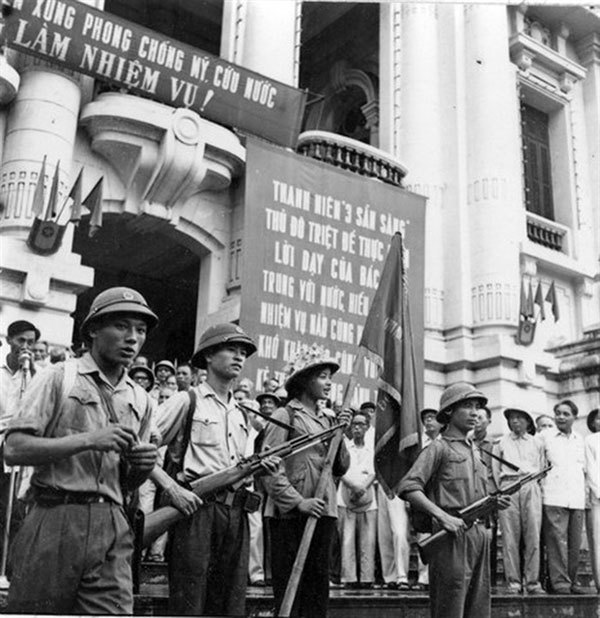 |
| A farewell ceremony to young Hanoian people, who volunteered to join the army to fight against American aggressors in the south, in Hanoi Opera House on July 11, 1969. VNA File Photo |
In early 1972, a train full of newly recruited soldiers, most of whom were students, departed from Kep Station (in the northern province of Bac Giang) to Vinh Station (in the central province of Nghe An). From Nghe An, they marched on foot to battle.
“When the train passed Hang Co Station (today’s Hanoi Station), many letters were dropped from the train to the roads,” recalled Nguyen Duc Thuan, a student from the College of Teachers.
On the envelope, there were words like: “Please if anyone picks up this letter, send it to house No…”, or “Wish for a return date”, “My beloved Hanoi”, or simply “Marching to B battle, date…” [to southern battle fields].
“The white letters covered the whole road at that time," Thuan recalled.
In their backpacks, besides personal items, many students did not forget to take along some books and notebooks as diaries.
Along the road, many of them sent letters back home to families, teachers and friends. When they had brief moments of respite from their duties, they wrote in their diaries.
The fierceness of the war is reflected in their diaries, like in a poem by martyr Nguyen Van Thac, a student from the National University, sent to his girlfriend Nhu Anh. The poem reads:
“Đêm trắng trong là đêm của em
Đêm thành phố và sao trời lẫn lộn
Đêm của anh xếp kín đầy bom đạn
Pháo sáng chập chờn trộn trạo với sao sa…”
(Peaceful night is yours
City night with stars twinkling
Mine is full of bomb and ammunition
Flares mingle with stars)
Inspiration for today’s youth
The students appeared in various fierce battles, from Quang Tri Ancient Citadel to East Southern battle, joining in liberating Buon Ma Thuot and marching to Sai Gon for the final victory on April 30, 1975.
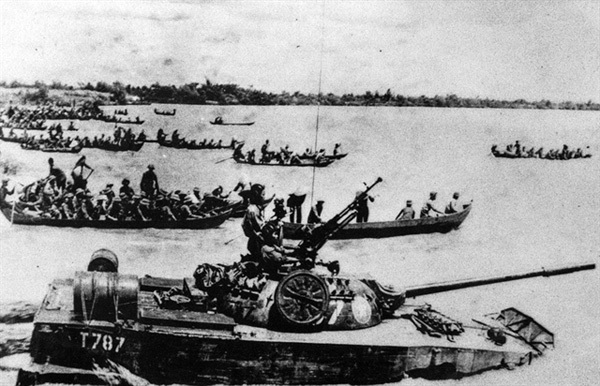 |
| Tanks and infantry of Army Corps 2 pass a river towards Sai Gon. VNA/VNS File Photo |
Many of them became heroes of the People’s Armed Forces like Vu Xuan Thieu, Tran Thanh Hai (from University of Science and Technology), Bui Ngoc Duong (University of Civil Construction), and Vuong Dinh Cung (University of Agriculture).
Five years after the country mobilised students to join the army, among the 10,000 that signed up, more than half lost their lives. Some died in the south, some in Laos but the greatest losses were seen in the 81-day campaign protecting Quang Tri Ancient Citadel in 1972.
Some of them lost their lives at the entrance of Sai Gon such as martyr Nguyen Van Tu (University of Science and Technology), at 10am on April 30, 1975, just two hours ahead of victory.
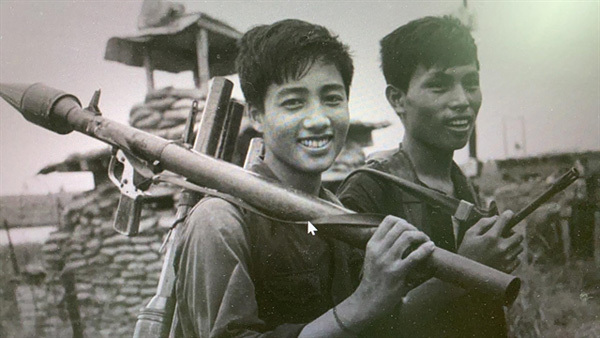 |
| Soldiers from Commando (Special Forces) Brigade 316 pose for a photo after the fight to protect Rach Chiec Bridge – a strategic bridge on Bien Hoa Highway, facilitating Vietnamese troop to march to Sai Gon. The fight at the bridge on April 27 and 28, 1975 has been considered as the last fierce fight of the historical Ho Chi Minh Campaign. VNA/VNS Photo Quang Thanh |
After reunification, the students who survived the war went back to their studies, but many of them were physically, mentally and emotionally scarred for life.
Many became scientists, professors at universities, army leaders, and writers. Their generation has become a bridge linking the past and present.
“The Motherland highly appreciated generations of teachers and students giving up pens to join the army to make contributions to the nation’s victory,” wrote late General Vo Nguyen Giap.
“Their patriotism will remain a flame brightening all generations of Vietnamese youth in the cause of developing the country, to make the country a wealthy, peaceful and happy nation.” VNS
By Thu Hanh
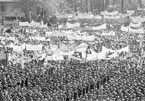
Ho Chi Minh Campaign – Strategic battle
The general offensive in the spring of 1975, with the historic Ho Chi Minh Campaign as its pinnacle, ended successfully, leading to the ultimate victory of the resistance war against the US aggressors and the country's reunification.
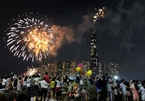
Ho Chi Minh City marks Reunification Day with fireworks
Firework displays took place in Ho Chi Minh City on the evening of April 30 to mark the 44th anniversary of Southern Liberation and National Reunification.
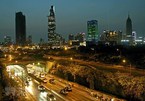
Southern region thrives after 45 years of reunification
After 45 years of national reunification and three decades of the Doi Moi (renewal) process, under the leadership of the Party, southern provinces and cities’ economy have thrived dramatically.
 The 1970s was a time of huge significance in Vietnamese history, not least for the generation who responded to the movement 'Putting away pens to go to the battle'.
The 1970s was a time of huge significance in Vietnamese history, not least for the generation who responded to the movement 'Putting away pens to go to the battle'.